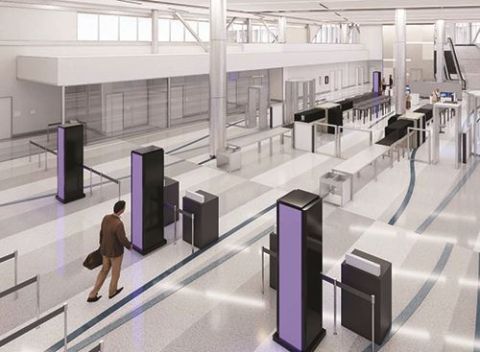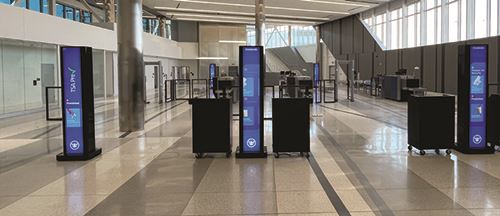New Terminal Connector/TSA Checkpoint Eliminates Passenger Flow Problems at Lehigh Valley Int’l

The historic COVID pandemic forced businesses around the world to rejigger, reconfigure and muster all the ingenuity they had to remain viable. Many adopted new technology that fast-forwarded them by a decade or more in a matter of months.
 At Lehigh Valley International Airport (ABE) in Hanover Township, PA, the pandemic exacerbated passenger flow problems the airport had wrestled with for years due to its antiquated underground tunnel to move passengers between the main terminal and its gates. When social distancing requirements required passengers to stay six feet apart, lines at the TSA checkpoint located inside the tunnel snaked around corners all the way to the baggage claim area. Despite formidable logistic challenges, ABE pressed ahead during the pandemic to fix the flow problems.
At Lehigh Valley International Airport (ABE) in Hanover Township, PA, the pandemic exacerbated passenger flow problems the airport had wrestled with for years due to its antiquated underground tunnel to move passengers between the main terminal and its gates. When social distancing requirements required passengers to stay six feet apart, lines at the TSA checkpoint located inside the tunnel snaked around corners all the way to the baggage claim area. Despite formidable logistic challenges, ABE pressed ahead during the pandemic to fix the flow problems.
Thomas R. Stoudt, executive director of the Lehigh-Northampton Airport Authority, knew well before the pandemic that the facility’s 1970s-era tunnel created congestion that had to be addressed. “The tunnel was never designed to implement Transportation Security Administration screening equipment post 9/11,” Stoudt says. “The equipment keeps getting larger in size with enhancements that produce the highest level of security and safety.”
|
Project: Security Checkpoint/Terminal Connector Location: Lehigh Valley International Airport (ABE) Owner: Lehigh-Northampton Airport Authority
Scope: New 40,000-sq.-ft. connector; 4-lane Cost: $35 million Funding: $15 million financed through local bank consortium; $7.04 million PennDOT Bureau of Aviation Capital Budget Grants; $5 million FAA Airport Terminal Program Grant; $4 million from Redevelopment Assistance Capital Program; $1.46 million PennDOT Multimodal Grant; $820,000 Alternative and Clean Energy Program Grant; $600,000 Community Project Funding Construction: June 2021-July 2023
Program Manager: Airport Design
Prime Consultant/Project
Mechanical, Electrical & Plumbing/Fire & Life Safety/Special Systems Civil Engineer: ADCI Geotechnical Engineer: Schnabel Structural Engineer: RS&H Design Architect: The Sheward Partnership, LLC General Contractor: Bracy Construction Inc.
Plumbing/Sprinkler Contractor: Electrical Contractor: Wind Gap Electric, Inc. HVAC Contractor: Master Mechanical Corp. TSA Checkpoint Equipment: 3 Smiths Detection advanced technology X-ray machines with alternate viewing station; 2 CEIA walk-through metal detectors; 1 Leidos advanced imaging technology passenger screener with co-located explosives trace detection; 3 Implant Sciences explosives trace detection machines; 2 Smiths Detection responder bottle liquid scanners Exit Lane Breach Control: dormakaba
Electrochromic Insulated Glass: Enhanced Air Purification System: LifeAire Passenger Instruction Displays: ReadySeeGo Digital Communication Totems by Synect Key Benefits: Enhanced security; improved passenger flow; room for checkpoint expansion |
That’s why the Airport Authority spearheaded a $35 million project to build a new TSA checkpoint and terminal connector. (See Facts and Figures section for a breakdown of the funding sources.)
Bursting at the Seams
ABE, the state’s fourth-busiest airport, serves communities throughout eastern Pennsylvania, including Allentown, Bethlehem and Easton. Construction of the existing terminal was completed in 1975; an additional concourse was added to the terminal complex in 1997; and a multi-year renovation and improvement project for the main terminal was completed in 2012.
Despite tremendous passenger growth throughout the years, passengers continued to use the original tunnel to get from the main terminal to all departure gates and vice versa. Navigating from check-in to a departure gate required going down a level to the TSA checkpoint, which was squeezed into the tunnel, and then going up as many as two levels, with all passengers needing to use a single escalator or small elevator. There were no stairs in case the vertical transportation wasn’t working—an issue addressed with system redundancy in the new terminal connector. Compliance with Americans With Disabilities Act standards was also improved.
Another complicating factor was that the tunnel could only house two TSA checkpoint lanes in order to leave enough room for arriving passengers traveling in the opposite direction to navigate the same multilevel course to retrieve checked luggage and access ground transportation. Under normal circumstances, the checkpoint was frequently backed up; but congestion became much worse during COVID, even with fewer passengers traveling. In a cruel but accurate joke, some referred to the tunnel checkpoint as the “TSA chokepoint.”
“The tunnel was designed as merely a walkway before we got into screening passengers and long before TSA,” Stoudt explains.
The need for changes was underscored in 2017, when Airport Authority leaders met with TSA to discuss the need for a third screening lane. Working with architect Michael Sheward, principal at The Sheward Partnership LLC, they ultimately determined the tunnel could no longer work for screening passengers.
“Even if Michael was able to perform a miracle and get three lanes in this underground location, we still had issues with the overall height—about 9 feet,” Stoudt notes. “We normally think about technology making things smaller, lighter, more compact. In the world of security screening with TSA, the equipment keeps getting larger because they keep adding capabilities to it. We’re enhancing what we can do in those security screening checkpoints, but the technology is getting taller and wider.”
Staying Committed Through COVID
Formal planning for construction of the new security checkpoint/terminal connector began in 2019. A year later, when the pandemic struck, the Airport Authority did not waver from its commitment to fix the checkpoint issues. Upon touring construction of the terminal connector last year, U.S. Department of Transportation Secretary Pete Buttigieg complimented the airport’s leadership and called the investment a “leap of faith.”
The Airport Authority secured a grant from the PennDOT Bureau of Aviation for $3.5 million, and Sheward was asked to design a new connector that would meet the airport’s needs for the next two decades and beyond. The project went out to bid in November 2020 during the height of COVID, signaling just how determined ABE was to resolve its security checkpoint and passenger flow problem.
Passenger volume post-COVID validated the decision to move forward with the project. In 2020, passenger traffic at ABE dropped to 390,764, the first time it dipped below 400,000 since 1972. In 2021, volume rebounded to more than 752,000 passengers, and the total hit 912,256 last year.
Looking back, Sheward says the airport considered more than 10 options for a solution before the design of an elevated connector with more intuitive wayfinding was approved. The connector added 40,000 square feet to the terminal complex, with ceilings up to 24 feet high to easily accommodate TSA scanning equipment.

The new terminal connector/TSA checkpoint has space for up to four lanes of TSA security screening, and more direct, intuitive flow for passengers. Now, they go through security and take an escalator or elevator to reach the departure gates. There’s no more going down, just to go up again.
A More Pleasant Travel Experience

“The main thing we try to do is manage passenger anxiety. It’s the biggest thing that undermines a positive passenger experience,” Sheward reasons. “Nobody looks at signs. They see [where they need to go] and flow to it. No matter how many times we did a design iteration utilizing the sub-level connector, we were still coming in high, going down low to go back up high and higher. It just didn’t make a lot of sense.”
The design that was executed advances the level of service for both departing and arriving passengers at ABE. Arriving passengers continue to use the tunnel to access luggage carousels, parking and ground transportation, but the tunnel is now more spacious since the TSA checkpoint has been removed. Work is expected to continue on the tunnel through the rest of the year, including installation of exit portal doors for security, plus new carpet and lighting.
 Cedrick Johnson, program manager for Airport Design Consultants Inc., notes that 34 local, regional and national TSA representatives were involved in the project, and they met 57 times with the ABE team to coordinate the TSA portion of the project.
Cedrick Johnson, program manager for Airport Design Consultants Inc., notes that 34 local, regional and national TSA representatives were involved in the project, and they met 57 times with the ABE team to coordinate the TSA portion of the project.
Features of the new, elevated connector include:
- an augmented security checkpoint with up to four lanes;
- adjacent TSA offices to increase the efficiency of TSA operations;
- separation of inbound and outbound passenger flow;
- improved restrooms, generator, substations and other infrastructure;
- enhanced air purification system and improved air circulation equipment; and
- electrochromic insulated glass that tints automatically to help minimize solar heat and reduce glare.
The new checkpoint will incorporate seven ReadySeeGo Digital Communication Totems from Synect. The portable, TSA-vetted displays provide passengers with instructions about how/where to divest their personal items and navigate through the security checkpoint.
 “Lehigh Valley International Airport’s new security checkpoint is a stunning example of how visual communication can transform passenger experience and make the airport work better for everyone,” says Synect Chief Executive Officer Yahav Ran. “Passenger anxiety typically spikes at airport security checkpoints, but ABE will engage and educate their passengers to help them prepare for screening. With Synect content and solutions, the airport will improve operations, increase throughput, decrease perceived wait times and enhance the passenger checkpoint experience. We are confident that the airport’s new security checkpoint will set a new standard for efficiency and passenger satisfaction.”
“Lehigh Valley International Airport’s new security checkpoint is a stunning example of how visual communication can transform passenger experience and make the airport work better for everyone,” says Synect Chief Executive Officer Yahav Ran. “Passenger anxiety typically spikes at airport security checkpoints, but ABE will engage and educate their passengers to help them prepare for screening. With Synect content and solutions, the airport will improve operations, increase throughput, decrease perceived wait times and enhance the passenger checkpoint experience. We are confident that the airport’s new security checkpoint will set a new standard for efficiency and passenger satisfaction.”
Synect also supplied the content for a large LED video wall in the passenger queuing area. The nearly 24-foot-wide, 5½-foot-tall display reminds travelers about TSA regulations, informs them about checkpoint wait times and provides other useful information.

Stoudt and other airport officials are also excited about the enhanced air purification system that was installed in the terminal connector. It was not part of the original plans, but the COVID pandemic triggered the decision to look for a system that could reduce airborne pathogens—a concern of airport leadership long before COVID. The system, which was developed by local company LifeAire Systems, reduces airborne pathogens (including COVID-19) by more than 99% and achieved a 96% reduction in harmful surface pathogens in a recent healthcare study.
“COVID wasn’t the first time that we dealt with a contagion or were put on alert about pathogens circulating through air travel,” Stoudt explains. “We would be remiss if we didn’t look at this facility and think about what we might need to have in place if we’re dealing with some other pathogen in the future.”
“It gets back to the idea of creating a stress-free environment,” he adds. “Even today, people are still moving through our facility with masks on. Providing high-level protection through the air was a way to future-proof whatever might be coming down the road.”
On the sustainability front, electrochromic insulated glass provided by Halio will automatically tint to help block excessive solar heat and reduce glare. Sheward notes that his architectural design firm doesn’t pick up a pencil without thinking about how a move will affect a building’s environmental impact. “You want buildings to sip energy, not gulp it,” he remarks.
For Stoudt and other ABE leaders, designing and outfitting the new security checkpoint/terminal connector was about improving the passenger experience as well as safety. “One of the things we hear about from our frequent fliers is they appreciate the ease, convenience and low stress that is created here that doesn’t exist at nearby large hub airports,” he reports.
Overcoming Supply Chain Challenges
Like most construction projects that were underway during and immediately after the COVID-19 outbreak, ABE’s terminal connector project encountered supply chain issues that forced drastic shifts in strategy. Key elements like the smart glass and exterior metal panels that were part of the terminal connector’s shell were on backorder for months.
“We kept moving by switching gears—doing what we could on the inside and building our way out,” recalls Tom Cook, project construction manager with Arora Engineers, which oversaw the construction teams. “We were shifting gears like crazy to find ways to move forward. If you look at projects today, many of them are four to six months later than scheduled. This team turned in a tremendous effort, and we were able to stay on schedule.”
On the positive side, construction of the elevated connector occurred without major disruptions to existing airport operations. “Construction at an airport is always like open-heart surgery in which the patient is running a marathon every day,” Stoudt muses. “You have to be concerned with how it synchs with operations. That’s another reason tearing apart the tunnel wouldn’t have worked. It would have been too disruptive.”
He expects TSA checkpoint times—a main metric that will measure the project’s success—to drop dramatically. (With construction scheduled to wrap up in July, no throughput statistics were available for this article.)
FREE Whitepaper
Fairbanks International Airport Baggage Transport Conveyor Enhanced With Mod Drive™ System
Airports face a host of unique industry challenges, such as meeting efficiency regulations and seeking out the best maintenance practices to reduce costs and keep operations flowing. In today’s current economic climate, any potential cost savings can go a long way.
In 2019, Alaska’s Fairbanks International Airport (FAI) sought to modernize its equipment and operations. They were dissatisfied with the performance of the gearmotors on their baggage transport conveyors and began searching for new suppliers. Regal approached FAI with a solution that could improve equipment performance and simplify maintenance, with the added benefit of energy cost savings: the Hub City® MOD Drive™ system.
This white paper discusses the hardware deployed, the test results and the annualized expectations for ROI.
 facts&figures
facts&figures








